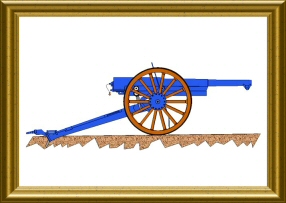|
|
|
|
|
|
|
 Italy
|
Cannone da 75 modello 1911 Deport |
 Light artillery
|
|
|
Contributor :
|
Location :
Italy
Rovereto
Museo Storico Italiano della Guerra
Coordinates :
Lat : 45.88740 / Long : 11.04890
|
General comments on this surviving gun :
Identical items in the same location :
1
Items covered by this file :
1
|
|

|

|

|
Two guns of this same type are presented in this wonderfully rich museum
|
View on the rusty breech markings : 'Terni 1918 - 75 Mod. 1911'
|
This one is shown in transport setup with its ammo container
|
|
|
Historic and technical information
|
|
Denomination :
75/27 mod. 11 Deport
|
Origin :
 (
Forges de Chatillon - Commentry)
(
Forges de Chatillon - Commentry)
 (
O.T.O. / Vickers Terni )
(
O.T.O. / Vickers Terni )
|
|
Historic context :
The Colonel Deport, once the director of the Ateliers de Puteaux, was one of the brilliant French military engineers that designed the famous canon de campagne de 75mm Mle 1897, one of the technological revolutions of the end of the XIXth century and a trigger for a modernisation race of the artillery throughout all the powerful nations. This great military engineer although resigned from the Army in 1894 before the manufacturing start, disappointed by the lack of recognition, and joined the private industry in the Forges de Chatillon.
Once there, he designed a new fieldgun even more revolutionary, particularly thanks to two main original and modern characteristics :
- a cissor tail (the very first in the world) allowing to improve the lateral stability if the weapon and avoiding the limitation of the recoil under high elevation angles
- a double recoil system including a first recuperating device on a fix hirizontal axus' assisted by a second one following the tube elevation angle.
The twin recoil recuperating system was designed in order to limit the overheating issues of the usual simple hydraulic ones, often too close to the barrel in the classic modern fieldgubs and causing troubles at high firing rates. Coupked with the cissor tail' it also gave way to a pretty high vertical elevation angle (over 45 degrees) and an impressive lateral aiming range up to 27 degrees to the left and to the right !
Despite its obvious qualities, this '75mm Deport' was not adopted by the French army, probably wanting to limit the materials variety and satisfied with its canon de campagne de 75mm Mle 1897.
But this goid gun was finally adopted in 1911 by the Italian army who was looking to replace its Krupp 75 mod. 1906 fieeldgun (with a too short range), after a comprehensive test of Schneider, Krupp and Deport materials. The 600 guns order of this canone da 75/27 modelo 11 was manufactured under license in Italy by a consortium lead by Vickers-Terni. This gun stayed in service after WW1 and participated to WW2. The range was increased during WW2 thanks to the use of optimuzed shells. It was only retired from the active service in 1950.
|
Technical data :
- Complete description : 75 mm fieldgun M 1911 Deport
- Design year : 1911
- Calibre : 75.00 mm
- Weight in firing position : 1076 kg
- Weight for transportation :
- Tube length in calibres : 27.00
- Grooves : 24 (28 degrees constant angle to the right)
- Projectile weight : 6.5 kg
- Initial speed : 510 m/s
- Fire rate :
- Range : 7600 m
- Elevation range : -15 to + 65 degrees
- Direction range : 53 degrees total range
|
Sources
|
|
|
|